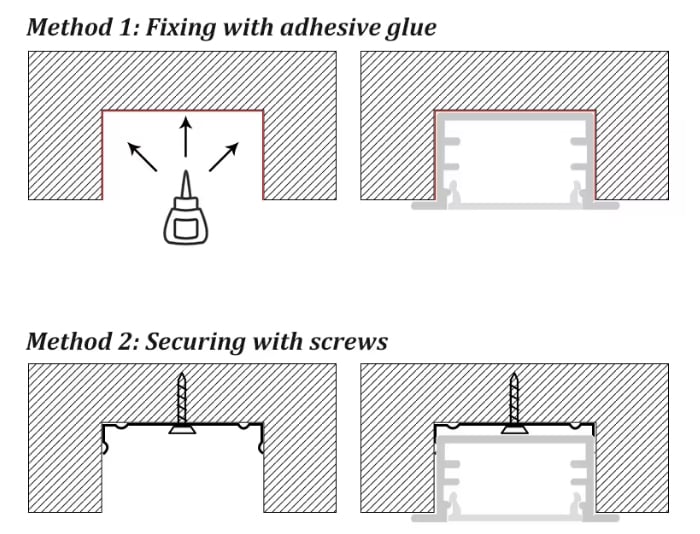 Recessed LED Strip Lighting - Recessed LED ChannelRecessed LED strip lighting is a popular choice for creating modern, seamless lighting effects in various applications. LED recessed channel is also known as recessed aluminum profile, widely used for LED strip light projects. Install LED strip light inside the channel to achieve better light diffusion and better heat dissipation. The channel can be shallow or deep, resulting in different diffusion effects. It can also protect LED strip light from possible external damages, such as water droplets, dust, scratches, collisions, etc. White LED Strips, RGB + White LED Strips, and Tunable White LED Strips paired with LED Recessed Channels are perfect for lighting and creating ambiance. Recommended Reading: Top 7 things you need to know before choosing LED strip channel.
How to Install Recessed LED Strip Lighting
Step 1: Choose the Right LED Strip
Step 2: Choose the Diffuser Cover
Step 3: Determine the Location
Step 4: Measure and Mark the Installation Area
Step 5: Cut the LED Aluminum Channel
Step 6: Prepare the LED Recessed Channel
Step 7: Install the LED Strip
Step 8: Wiring and Testing
Step 9: Finishing
Step 10: Final Adjustments Recessed LED Strip Lighting, combined with LED Recessed Channel, offers the perfect solution for modern lighting design. Whether in home decor or commercial spaces, this concealed lighting method provides clean, contemporary aesthetics while improving the functionality of lighting. If you’re looking for a lighting solution that’s both beautiful and practical, Recessed LED Strip Lighting and LED Recessed Channel are the ideal choices. Recessed LED Channel with Light Strip for Minimalist Lighting
1. What is Recessed LED Strip Lighting?
2. How Does Recessed LED Strip Lighting Work?
3. Why Choose Recessed LED Strip Lighting? 
4. The Role of LED Recessed Channel Recessed LED Strip Lighting: The Perfect Hidden Installation
LED recessed channel Purchase Option 
Installed LED recessed channels with and without wings
The above picture illustrates the installed LED recessed channels with and without wings. The left is the recessed channel without wings, the right is with wings. Before choosing recessed channels with or without wings, you want to consider the edges of the groove where you put in the aluminum channels. If the edges can be made smooth and nice, you can consider recessed channel without wings. Otherwise consider only those with wings. 
Two types of LED recessed channels
The above picture shows another two types of LED channels that can be recessed mounted. To the left is the channel with wings, to the right is the channel without wings. For the LED recessed channel with wings, there are also two types of wings. One type is solid, and it has the same appearance as aluminum channels. The other type of wing is perforated or beading for plastering over. With this type of channel, the wings are invisible after installation, so it is sometimes called trimless channel. The advantage of the LED recessed channel with solid wings is that the wings can cover the unpleasant unevenness of the installation groove. To mount the recessed channel, we need trench a groove to lay in the aluminum channel, or put the aluminum channel in between two mounting surfaces. The edges of the grooves or mounting surfaces may be uneven. The wings of the recessed channel can cover the uneven groove edges to make the installation neat and beautiful. The LED recessed channel with plaster bead or perforated wings is designed to use plaster to cover and mount the wings. The design allows plaster finishing up to the level of the diffuser. When finished, the wings are hidden and integrated into the entire installation surface such as drywall or ceiling. Only stylish linear lighting is visible. No trim! The plaster bead is also to enhance the bonding force with the covering material. The covering material is more strongly combined with the wings, the installation is more stable. The aluminum channel without wings can also be used for recessed mounting installation. The result of this installation is that there are no two extra lines of aluminum wing, and the installation surface looks more concise. However, this requires that the edge of the installation groove is very flat and smoothly even. Otherwise, the finish will be unpleasant. Recessed LED strip lighting allows you to see the light without seeing the fixture, creating a simple and beautiful effect.. LED recessed channel is often sold and used with both LED aluminum channel and diffuser cover included. The aluminum channel is recessed mounted into the surface, such as drywall, ceilings, and shelves. Compared with the traditional lamps that are usually prominent, LED recessed channel with LED strip light can keep the mounting surface flat without protrusion. It offers a neat and stylish lighting enjoyment. Please see LED strip channels for all aluminum LED channels we carry, including slim and low profile, middle sized, and large sized. Applications of Recessed LED Channel Lighting
|

















